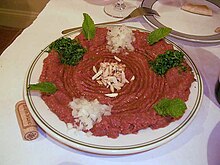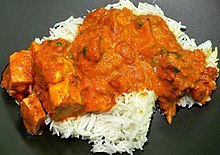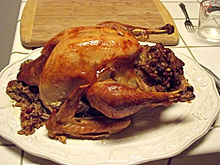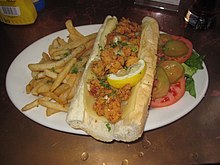Meat is a delicacy in most parts of the world. However, many people do not eat meat, for ethical, environmental or religious reasons.
Different cultures have different ideas of what counts as meat. It usually includes muscle and other tissues from land animals, such as mammals and occasionally reptiles or amphibians; the term may or may not include birds (poultry) or seafood. Meat from aquatic mammals such as seal or whale can count as both. For the purpose of Catholic dietary law that separates animals into "meat" and "fish", a lot of animals used to be considered "fish" just because they live close to water. Examples include beaver, turtles and even some aquatic birds.
Species and their meats
[edit]Land mammals
[edit]Pig
[edit]
The pig is the most eaten mammal worldwide. While pork is taboo in Islam and Judaism, it is ubiquitous in most cuisines of Europe and East Asia. In fact, the Chinese word for 'meat' (
Pork is a popular meat served in a number of cuts. For example in the United Kingdom bacon and pork chops are very popular while in Germany a hock or knuckle known as Schweinshaxe and Schnitzel (although "Wiener Schnitzel" is traditionally made from veal) are traditional dishes. In China, pork belly, which is about half meat and half fat, is much appreciated. This is the cut used to make what the U.S. and Canada call "bacon".
Hungary is home to the Mangalica (or mangalitsa) pigs, which are uniquely unctuous and form part of the taste and texture of much Hungarian food that features pork.
In addition to farming pigs, people hunt wild boars in many countries. One country that particularly loves wild boar is Italy, where it is called cinghiale and may feature in both primi (pasta courses) and secondi (meat courses).
Different forms of pork-based sausage are also popular in much of Europe, especially Poland and Germany, and also in China, Thailand and various other places.
Ham, a cured meat that can be lean or fatty, is a very common base for sandwiches in many countries and also a traditional centerpiece of Christmas dinners. Dry cured hams are often used to produce soups due to their strong flavour, with the Chinese Jinhua ham being an essential ingredient in Buddha jumps over the wall. Several countries including Poland, France, Spain, Germany, Italy, the United Kingdom, the United States and China are famous for their specialty hams.
Bacon, a salty, fatty cured meat, is a traditional breakfast food in several countries, including Canada, the United States, the United Kingdom and Australia. Lardons, a related cut, are a staple of French food. Keep in mind that the unqualified term "bacon" has different meanings around the world. In Canada and the U.S., it's made from pork belly; this would be called "streaky bacon" (or sometimes "side bacon") in the UK and Ireland. "Bacon" in the UK and Ireland is a leaner cut, made from the loin in the middle of the pig's back; this would be called "back bacon" in North America. In Australia and New Zealand, "bacon" by itself usually refers to "middle bacon", which includes some belly meat and a smaller section of the loin of back bacon. Some supermarkets in that region sell the loin section only under the name of "short cut bacon". Japanese bēkon (ベーコン) is the same as North American "bacon", but is sold processed and precooked.
Italy is well-known for cured pig meats including prosciutto di Parma and prosciutto di San Daniele, which is traditionally eaten with melon and/or cheese. Spain is known for two variants of cured ham: jamón serrano and jamón ibérico. Germany is known for Black Forest ham (Schwarzwälder Schinken) and Westphalian ham (Westfälischer Schinken).
Cattle
[edit]

Cattle are high-status animals in most cultures, and too sacred to kill or eat in Hinduism (even non-vegetarian restaurants in India rarely if ever serve beef). While beef is otherwise popular around the world, parts of North and South America and Oceania in particular — notably including the Pampas in Argentina, the Great Plains states and parts of Texas in the United States, and the prairie provinces of Canada (especially Alberta) — were mainly colonized by cowboys and other cattle herders and therefore have a culture of both cattle-raising and beef-eating. While cattle ranching is criticized for high water consumption and methane gas emissions, open-land grazing can also improve biodiversity.
There are many cuts and methods of cooking and serving beef. The best steaks can be found from cattle that have grazed naturally in places such as the Midwest, Texas, Alberta, Australia and Argentina. Argentina and Uruguay are renowned as countries where one can get high-quality beef that is inexpensive for many visitors, due to exchange rates, and wash it down with some good local wine. In Europe, Scottish Angus beef is highly regarded. One of the most expensive types of beef is Kobe beef from Japan, which has a fatty marbled texture that truly defines the phrase melts in your mouth, though there are even more premium and expensive types of beef that are not exported and can only be found in Japan.
Traditionally, beef was rarely eaten in large quantities by commoners in Korea, but as a result of South Korea's tremendous economic growth since the Korean War, a taste for beef has been cultivated by the masses. South Korea today is known for Korean barbecue, especially of beef and pork. The best-known cuts of beef for Korean barbecue are galbi (marinated short ribs) and bulgogi (marinated sirloin or other prime beef), and there are many barbecue eateries throughout South Korea.
In Indonesia, Malaysia and Singapore, beef is the most common meat used in the traditional dish rendang.
Minced, chopped or ground beef is used in a number of forms from Bolognese sauce served with spaghetti to the raw steak tartare. Of course, one of the most common ways to eat beef is in the form of hamburgers, which have been popularized the world over by US-based fast food chains.
Veal, the meat of calves, is much appreciated in Europe and many European-influenced countries. White veal is from calves who are separated from their mothers without being able to nurse from them and made anemic, so many people avoid white veal out of ethical concerns for how the animals are treated, in favor of red veal. Veal cutlets and dishes like veal parmigiana are nonetheless commonly found in many places.
Beef and veal organ meats are highly appreciated in some countries. In Peru, a dish called anticuchos is made with beef hearts.
Water buffalo
[edit]Water buffaloes are often found in Southeast Asian tropical countries which practice or until recently practiced wet rice cultivation, including the Philippines, where they are called carabao and Malaysia and Indonesia, where they are called kerbau. Water buffalo meat is similar to beef but must be boiled for a long time to be tender enough to eat, so it is normally used in long-cooked stews or curries. It is often substituted for beef while being described as beef on the menu. That is not really a dishonest practice, because although the two meats are not quite the same even after lengthy boiling, water buffalo meat is quite an adequate substitute for beef in these kinds of dishes. Water buffalo is particularly common in Nepali cuisine.
Horse
[edit]Horse meat is taboo in many countries, for religious reasons, or for the importance of horses as working and riding animals.
Horse meat is ubiquitous in Central Asia and Mongolia and an important part of the cultural identity of the people on the nomadic steppes. It is also commonly eaten by some ethnic minorities in China such as the Kazakhs and Mongols.
Steaks, found in Belgium, France, Quebec and Germany can have very rich flavours. Rheinischer Sauerbraten, a staple of cuisine in the Rhineland of Germany, is traditionally made with horse meat. Other regional variations of Sauerbraten are made from beef, as is the Rhineland variation in some cases.
Horse meat sashimi is a local delicacy in the Japanese city of Kumamoto.
Kangaroo
[edit]
Kangaroo is a lean red meat that is available but not eaten widely in Australia. It is found in specialized stores even outside Australia, and can sometimes even be had in regular supermarkets.
Sheep
[edit]Though sheep are more treasured for their wool and milk, their meat can be delicious. They are important to regions with poor soil, such as the Middle East, Central Asia, Iceland and Australia.

Lambs are taken when they are only a few weeks old and have only grazed on grass after milking. They are raised in places such as United Kingdom, Italy, Australia and New Zealand. Older sheep meat is called mutton and is relatively tough to eat, making it less popular. Mutton is very commonly eaten in Mongolia, such that even in a pizza restaurant in Ulaanbaatar, "pizza alla Mongola" was topped with mutton. Mutton barbecue (cooked by slow smoking, traditionally with a wood- or charcoal-based fire) is popular in parts of the American south, with Owensboro, Kentucky especially famous for this dish.
Goat
[edit]
Goat meat is a favorite in many Muslim countries and also among meat-eaters in the Indian Subcontinent and on the Chinese island of Hainan. It is widely served in Mexico, particularly in the northeast where cabrito is a regional specialty. In most of Europe, goats are more often prized for the cheese produced from their milk than for their meat. If you are in a country where goat meat is not mainstream, look for it in a halal butcher shop. Goat meat is a bit gamy, but perhaps a bit less so than lamb.
Goat meat is sometimes inaccurately called (or translated into English as) lamb; conversely, in countries where lamb is more widely available and generally preferred, including the United States, dishes from countries such as India, Malaysia and Indonesia that are traditionally made with goat are often made with lamb. However, the tastes of the two meats are not highly similar.
Deer
[edit]Deer meat is commonly called venison. It has been prized in Europe and European-influenced lands for thousands of years. Its taste tends to be quite gamy.
Reindeer and elk
[edit]Reindeer (known as "caribou" in North America) and elk meats are popular in northern areas where those types of deer live, such as the Nordic countries and Alaska. Reindeer are important to the Sami people, as well as several ethnic minorities in Russia and the Evenks in China.
Here, "elk" refers to the deer known in North America as the "moose". Meat from the North American "elk" (still another species of deer) enjoys some popularity in the American and Canadian west.
Hare and rabbit
[edit]Hares and rabbits are considered delicacies in European countries such as France and Italy. Rabbit dishes are common in regional Mexican cuisine. Some people may find their taste overly strong.

Guinea pig
[edit]Guinea pigs are called cuy and considered a delicacy in the Andes. Cuy meat is easy to find in Peru, and if you have the opportunity to visit a traditional Andean home, you may see the little animals scurrying around the kitchen.
Capybara
[edit]Hydrochoerus hydrochaeris is the largest living rodent in the world, native to South America, closely related to the guinea pig and the rock cavy. In parts of South America, especially in Venezuela, capybara meat is popular during Lent and Holy Week as the Catholic Church previously issued special dispensation to allow it to be eaten (popular legend says the logic of this is, as it lives on water, it is "fish") while other meats are generally forbidden.
Dog and cat
[edit]Dog meat is served at specialty restaurants in South Korea, China, Vietnam and in parts of Indonesia. In China, there is also a cat meat industry. The practice of slaughtering cats and dogs is controversial even in countries where it occurs, and it is extremely unlikely that you could ever accidentally eat the meat of either animal, despite any rumor you might hear. For example, in South Korea, the specialist restaurants that serve dog meat are inconspicuous, and you would be very unlikely to accidentally walk into one.
Bats
[edit]Northern Sulawesi is where you should head if you should fancy some fruit bat. Local cuisine also includes dogs and forest rats.
Marmot
[edit]Traditional cuisine in Mongolia includes a dish called boodog — that's marmot cooked in its skin on hot stones.
Poultry
[edit]Chicken
[edit]
There are 24 billion chickens on the planet, outnumbering each wild bird species. The taste is so well-known that "tastes like chicken" has become a cliché to describe many kinds of exotic food. Not forbidden by any major religion, chicken is eaten around the world, though it has a justified reputation to contain toxic germs; see traveller's diarrhea. Chicken has become so ubiquitous in parts of the world that some American fast food chains have specialized in nothing but greasy fried chicken. Chicken does have a place in haute cuisine: Bresse chicken (poulet de Bresse), which is farmed in Rhône-Alpes, Burgundy and Franche-Comté, is much prized in France. In China, silkie, which is commonly called black chicken for the color of its skin and has quite a distinct taste from ordinary chicken, is used in soothing medicinal soups. Some cities in China are also famous for their gourmet chickens, such as Zhanjiang and Qingyuan in Guangdong, and Wenchang in Hainan. In Malaysia, kampung chickens (ayam kampung), which are free-range yardbirds raised the traditional way in Malaysian villages, are much sought-after for their uniquely delicious taste, which could be described as much more chickeny than mass-produced factory-farmed chicken. However, chances are, unless you are specifically looking for gourmet varieties of chicken, your chicken meal probably won't be a gastronomic taste sensation.
One interesting thing about chicken is that different cultures tend to have different attitudes about eating chicken organ meats. For example, at a Chinese banquet, the person being celebrated gets the honor of eating the head, whereas in the United States, when heads have been accidentally left on chickens, there have been press reports of customers panicking and even suing for emotional distress. In China, chicken feet are also appreciated and come in white (just a bit of skin on the bones) and yellow (more to eat) varieties. Chicken feet in black bean sauce, served with yellow chicken feet, is a classic dim sum dish, dim sum (
Another contrast is in preferences for dark and white meat. In the U.S., chickens have been bred to produce more white meat, whereas in China, they have been bred to produce more dark meat. Dark meat contains more fat and is tastier, and those are either positive or negative, depending on your desire for stronger or milder taste and more or less fat.
Duck
[edit]
Duck meat is prized in China, wellspring of the world-famous Beijing kao ya (Beijing or Peking roast duck), and France, where canard a l'orange (duck in orange sauce) is a classic dish and cherries are another classic accompaniment to duck. Ducks have a layer of fat they need for insulation in cold water, so their meat is much fattier than chicken. It is also completely dark meat and has a taste quite distinct from that of chicken.
France is also known for its love of duck organ meats. In particular, foie gras is traditional, and often served as a paté. Foie gras literally means "fatty liver", and it is made from the livers of ducks, or sometimes geese, that have been specially fattened. Even some people who normally don't like liver may like foie gras, because it has what many people think of as a much more refined and somewhat buttery taste. It is classic to serve foie gras with fruit and accompany it with a sweet wine like Sauternes, but many other combinations are possible. Some places, including California, have banned foie gras because of controversy over the way the ducks are fattened, so if that's a concern of yours, inform yourself about the standards and practices of farms that produce foie gras in the region where you may be eating it and decide according to your conscience.
The French also love gesiers de canard — duck gizzards. Even in a bar, you may be able to order a delicious salad with confit de gesiers de canard. Confit — when not applied to the separate technique of candying slices of fruit or entire fruits in hot sugar syrup — refers to boiling things (meat or sometimes vegetables) in duck fat, or sometimes goose fat. It is a favorite cooking technique in France, and when you try anything confit, you'll understand why.
Duck eggs are much prized in China. Their taste is stronger than that of chicken eggs, and they have twice the amount of fat, half again the amount of protein and well over 1/3 more sodium than chicken eggs, though they are also about 40% bigger on average.
Turkey
[edit]
Turkey is the classic centerpiece of Thanksgiving meals in the United States and Canada, and is usually served for Christmas in other parts of the English-speaking world. It's also the leanest commonly available meat in many countries and is typically used in deli sandwiches. Its taste is mild, and its white meat can be dry. In Taiwan, the city of Chiayi is famous for its turkey rice.
Goose
[edit]Geese are eaten in places as diverse as Austria and Hong Kong. Geese are fattier than chickens but less fatty than ducks, and the taste of their meat is somewhere between the two in a way, yet unique. Geese are very big birds, so a single goose leg could feed more than one person.
Guinea fowl
[edit]Also called guinea hen, this chicken-like bird is called gallina in Spanish. It is a tough bird, and Dominicans like to make a tasty tomato sauce-based stew out of it (gallina guisada). Guinea fowl dishes are also found in various European countries.
Quail
[edit]Quail is another chicken-like bird. It is smaller than a chicken and has a lot of small bones. Otherwise, it does taste something like chicken. You may find quail stews or roast quail on menus of restaurants in Europe, especially those specializing in game.
The small quail eggs are also much appreciated, not only in Europe but also and perhaps to a greater degree in China. They taste similar to chicken eggs but there is a noticeable difference.
Ostrich
[edit]
Ostriches run around a lot, and their meat is very lean. These large flightless birds are native to Africa but are now farmed in other parts of the world as well.
Pigeon
[edit]Also called squab, pigeons are bred and eaten primarily in Europe. They are much smaller birds than chickens, so there's much less meat on their bones, but if you like chicken, you'd probably like pigeon. Pigeon is also eaten in Guangzhou and Hong Kong, China.
Pheasant
[edit]A popular game bird in England that regularly features in English cuisine.
Emu
[edit]Native to Australia, where it often appears in menus, but is less common than chicken. It is available at supermarkets.
Amphibians and reptiles
[edit]Alligators and crocodiles
[edit]
Alligator meat is part of Louisiana cuisine. Crocodile meat can also occasionally be found on the menu in Florida, South Africa and Australia.
Frog
[edit]Frogs are considered a delicacy in France, China, Vietnam and Thailand, among other places. Some people say frog tastes like chicken, but it really doesn't, and just because you like chicken, don't assume you'll like frog.
Snake
[edit]Snakes are eaten in China and various other parts of East and Southeast Asia.
Turtle
[edit]Turtle soup is traditional in places as diverse as England, the US state of Louisiana and many places in the Far East (especially China's Guangdong province).
Aquatic mammals
[edit]Whale and dolphin meats are eaten in Japan. Since whales and dolphins are mammals, their meat reportedly tastes something like steak, but with a bit of fishiness as a result of their diet. Only a few other countries (most notably Iceland and Norway) eat the meat of cetaceans, which is banned in many parts of the world. In addition, members of Canadian First Nations and Native Alaskan tribes that have traditionally subsisted in part on whale meat have a special exemption from general prohibitions on whale hunting in Canada and the U.S. In southeastern Michigan, muskrat is sometimes eaten by local Catholics on Fridays.
Insects and arthopods
[edit]
Yes, there are places in the world where insects and other creepy-crawlies are eaten intentionally. Crickets are eaten in Mexico, ant eggs are considered a delicacy in the northeastern Isaan area of Thailand and neighboring Laos, spiders have been popular since the times of severe food scarcity during the Pol Pot regime in Cambodia, and many varieties of insects and land arthropods such as scorpions can be found in outdoor markets in cities such as Beijing and Bangkok. The Hebrew Bible excludes four types of locust from the otherwise complete ban (according to kashrut) on insects, spiders and the like, and Talmudic rabbis identified eight kosher varieties, but only the Yemenite Jewish community claims to still know which insects the ambiguous Hebrew words in the Torah actually refer to - the general consensus among other kosher-observant Jews is that it is better to abstain from all locusts in order to not accidentally consume a non-kosher one. During times of locust infestations, many Israeli restaurants serve locust.
Stay healthy
[edit]
Meat is a high-risk foodstuff, when it comes to parasites and bacteria. Raw meat is always suspect, as heat from cooking resolves most issues. Rare or lightly-cooked meats require caution as well.
Poultry and ground meat in particular require caution. To ensure your safety, always make sure poultry and ground meat are thoroughly cooked. If you have a meat thermometer, the internal temperature should read above 75°C or 165°F when fully cooked.
Respect
[edit]Raising animals for food is seen as problematic for a number of reasons, as is hunting. Traditionally meat has served a much smaller role than today in most cuisines – valued, but too expensive to be everyday food. As people have got richer, meat consumption has rocketed.
The need for pasture and growing crops for fodder is a threat to many natural ecosystems – although others have indeed developed through livestock raising, and are instead threatened by pastures being transformed into fields or woods. You might want to read up on the local situation.
While you might want to strictly avoid dishes based on endangered animals, otherwise what matters most is what you eat at home, every week of the year, rather than at a few dinners when travelling. Still, in some areas, what rich tourists prefer may have an impact on what locals will regard as high-status – and by asking for meat where the diet otherwise is mostly vegetarian, you may miss a lot of delicious experiences. You might instead get a mediocre version of what you can get without travelling.
You may also want to avoid food that is taboo at your destination. While you may get pork in a Islamic country, the cooks and waiters might not like to have it on the menu. Choose among the locally preferred dishes instead, and chances are you get a better meal.
